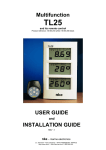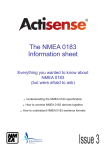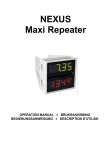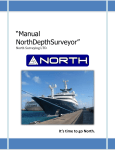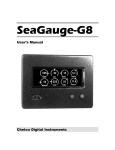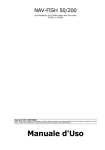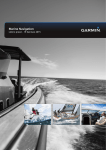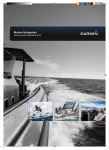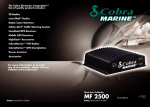Download The NMEA 0183 Information sheet
Transcript
The NMEA 0183 Information sheet Everything you wanted to know about NMEA 0183 (but were afraid to ask) Issue 1.50 Understanding the NMEA 0183 specification How to connect NMEA 0183 devices together How to understand NMEA 0183 sentence formats Actisense™ Contents Important Notices Notices Feedback! NMEA 0183 Introduction 3 3 3 4 Connecting devices together 7 Connecting a differential NMEA talker to other devices 8 Connecting a single-ended NMEA talker to other devices 9 The basics Electrical specification Communication specification Connecting a computer to your NMEA 0183 system Testing the computer connection with ‘HyperTerminal’ Example data using an Actisense talker device PC OPTO-Isolation cables NMEA Data Multiplexers / Combiners NMEA Buffers NMEA Autoswitches The NMEA 0183 signals The different versions of the NMEA 0183 standard NMEA Listener device (1): Standard differential NMEA 0183 v2.0+ device NMEA Interface (2): PC with an opto-isolated input (via Actisense™ PC-OPTO-1) NMEA Listener device (3): Single-ended NMEA interface device NMEA Listener device (1): Standard differential NMEA 0183 v2.0+ devices NMEA Interface (2): PC with an opto-isolated input (via Actisense™ PC-OPTO-1) NMEA Listener device (3): Single ended NMEA interface devices 4 4 4 5 5 6 7 7 7 7 7 7 8 8 8 9 9 9 NMEA 0183 Sentence Format 10 Contact Information Company Information 12 12 DBT – Depth Below Transducer DPT – Depth MTW – Mean Temperature of Water VHW – Water Speed and Heading VLW – Dual Ground/Water Distance © 2006 Active Research Limited 11 11 11 11 11 Page 2 The NMEA 0183 Information sheet Important Notices This Actisense™ document is for informational purposes only, and to the best of our knowledge, the information contained within is accurate and true. Any use of the information contained within this document is solely at the user’s own risk. No responsibility will be accepted for any personal injury or damage to a boat or its connected equipment resulting directly or indirectly from information contained within. Navigational equipment used onboard a boat can be critical to the safe passage of the vessel, so if in doubt, contact an expert equipment installer before making any modifications to your current system. Unfortunately, we cannot published the entire set of NMEA 0183 sentence formatters here, as it is copyrighted by NMEA and must be published from the NMEA website see the NMEA contact details at end of document. Notices When using this document, keep the following in mind: The information contained in this document and any specifications thereof may be changed without prior notice. To obtain up-to-date information, contact Active Research Limited (refer to the Contact Information section) or visit the Actisense™ website (www.actisense.com). Active Research Limited will not be liable for infringement of copyright, industrial property right, or other rights of a third party caused by the use of information or drawings described in this document. All rights are reserved: The contents of this document may not be transferred or copied without the expressed written permission of Active Research Limited. Feedback! This document has been produced from some of the knowledge and experience gained by Actisense from many years of experience in NMEA interfacing. Please report any errors, omissions or inaccuracies to Actisense - we intend this document to be a useful resource tool to installers new to NMEA 0183 and inevitably we may have missed out the vital piece of information that they may have required to achieve a working NMEA 0183 system. © 2006 Active Research Limited Page 3 Actisense™ NMEA 0183 Introduction Designed over 20 years ago, the NMEA 0183 slowly became the common method by which marine electronics devices could talk to one another. The standard specifies both the electrical connections that make up an NMEA system, and the format of the data sentences that carry the NMEA information. The NMEA 0183 standard is a purely digital data transmission scheme, using ‘1’s and ‘0’s in a binary format, to communicate a digital representation of the required information (depth, speed etc.) to a connected device. The need for NMEA 0183 evolved from the earlier “NMEA 0180” and “NMEA 0182” standards. Because they differ in baud rate and transmission parameters from NMEA 0183, they are completely incompatible with NMEA 0183. Similarly, the new “NMEA 2000” standard is totally different, and the two networks cannot be mixed without using a special gateway device to convert between the two standards (the new Actisense NMEA 2000 Gateway). The basics NMEA data is transmitted from an information source such as a GPS, depth sounder, or gyro compass etc. These data sending devices are called “Talkers”. Equipment receiving this information such as a chartplotter, radar, PC or NMEA display is called a “Listener”. Unfortunately, only one Talker can be connected to a single NMEA 0183 data line at any one time. Two or more Talkers are simply not possible on the same data line as they are not synchronised to each other, and will attempt to ‘talk’ at the same time (over each other). This will resulting in corruption of the NMEA data, and potentially in disaster if valuable data such as navigation information is lost or corrupted so that it is incorrect and/or misleading. It can even lead to one or both of the Talkers becoming damaged. Electrical specification The latest specifications for NMEA 0183 (version 2 and onwards) should, as a minimum, meet the requirements of the computer standard “RS422” (Standard EIA-422-A). They use +5 / 0 volt signalling, which is low voltage and easy to interface to computer equipment. However, voltage levels present on an NMEA 0183 bus can be much greater - up to +/- 15 volt, particularly where older equipment is used, as the original version 1 specification used +/- 12-15 volt signalling. Thus, all NMEA 0183 inputs conforming to v2.0 and higher should be capable of receiving +/- 15 volt differential signals without causing damage. The NMEA 0183 specification also requires that all receiving equipment must be opto-isolated; this optoisolation requirement reduces the chances of interference and removes the problem of ground loop effects. Communication specification The data communication specification for NMEA version 1, 2 and 3 is essentially the same as RS232 with the settings: 4800 baud, 1 start bit, 1 stop bit and “No Parity”. In addition, NMEA 0183 version 3.0 added a new baud rate of 38400 baud. This is known as “NMEA 0183-HS” This was to allow for the latest ARPA and AIS equipment which require a higher baud rate link to send the larger quantity of information they produce in a timely manner. The data sent is all in printable ASCII form, so may be viewed directly on a PC “terminal” type program (like ‘HyperTerminal’) - even though what is seen may not make much sense. Note: NMEA 0183-HS or NMEA 0183 v3 is in no way related to the new NMEA 2000 standard (as is incorrectly suggested by some manufactuers), which uses a totally different electrical connection standard that is not compatible with NMEA 0183 in any way. If you require to convert between NMEA 0183 and the new NMEA 2000 network, the Actisense NMEA 2000 Gateway will allow full bi-directional conversion between these two very different standards. Please visit the Actisense™ website for full details. © 2006 Active Research Limited Page 4 The NMEA 0183 Information sheet Connecting a computer to your NMEA 0183 system Testing the computer connection with ‘HyperTerminal’ Many installations have been performed where the NMEA 0183 data signal of a talker is connected to the computer RS232 “Rx” line, and the ground of the talker to the Computer “Ground “ connection. This can be found in the Windows Start menu under ‘Accessories → Communications’. As the NMEA specification basically uses the same asynchronous comms specification in accordance with ANSI standard as used on a standard PC serial port, most PC’s can read NMEA directly through their Comms port. In our experience, almost 100% of PC’s will show the data of the NMEA link with this simple connection. This is dangerous and most definitely not recommended, however, as high voltage spikes can be present on the signal cable, by induction from motors, alternators, radar pulses, high power radios etc. and will damage the Comms port on a laptop or PC that has only been designed for domestic use. If you don’t have special navigation software installed yet, you can test whether data is entering your serial port using the “HyperTerminal” program included with all windows systems from Windows 95 onwards. Start the HyperTerminal program, and it will ask you for a new connection. Select an icon and give the connection a name. Select “COM x” in the port setup dialogue box (where x is the number of the Comm port which the NMEA device is connected to). This happens all the time, and has even happened to our lab PCs in controlled conditions. We now always use Opto isolators on our test benches (see below). Connecting directly to the computer RS232 port also breaks the NMEA 0183 requirement for opto-isolation between Talker and Listener; therefore there may be warranty conditions to this effect on equipment sold for marine use. This opto-isolation requirement was created to prevent ground loops within an NMEA 0183 system - this can be a bigger problem than the high voltage spikes, as ground currents can destroy a PC by allowing amps of current to flow through the delicate printed circuit boards within. (See the Actisense ground loop information sheet for more information). To safely interface to the NMEA 0183 system on a boat, it is best to obtain an opto-isolated NMEA to RS232 adapter cable (called the PC-OPTO-1) which is available from the Actisense™ website. Simply plug the PC-OPTO-1 in to the PC port (see Connections section of this document), and connect the open end wires to the NMEA 0183 lines. On the dialogue box (above), select 4800 Bits per second, 8 Data bits, Parity “None”, Stop bits “1”, Flow control “None”, and then click on “OK” to connect to the port. You should now see the so-called NMEA “strings” displayed on the HyperTerminal display. This data is in the “raw” NMEA 0183 format, and is “decoded” by navigation programs to provide you with all your navigational data. The data looks a little odd at the moment, so how can you understand what the data is? The answer is simple. The data is formatted according to the NMEA 0183 standard, which states how the data should be transmitted, and what should be transmitted where in each sentence. Refer to the NMEA 0183 Sentence Format section of this document for more details. © 2006 Active Research Limited Page 5 Actisense™ Example data using an Actisense talker device By connecting a so-called “Triducer” from a company like Airmar (www.airmar.com), or direct from the Actisense™ website, it is possible to measure the four quantities of depth, speed, log (distance) and temperature in just one device with a considerable cost saving versus buying each transducer/device separately. Plus, all this data is supplied through just one NMEA 0183 port. The Actisense™ active depth sounder module (DST-2) has the same Digital Signal Processor unit, but can connect to any Triducer (Depth, Speed & Temperature), Biducer (Depth & Temperature), or Depth only transducer. It allows easy conversion of the analogue transducer signals into the digital NMEA 0183 sentences. These two sensor types output the NMEA strings ‘DBT’, ‘DPT’, ‘MTW’, ‘VHW’ and ‘VLW’. Why do the strings have these names, and what data do they contain? Refer to the NMEA 0183 Sentence Format section of this document for more details. © 2006 Active Research Limited Page 6 The NMEA 0183 Information sheet Connecting devices together Actisense™ produces a full range of products to solve all NMEA interfacing and interconnection requirements, including: PC OPTO-Isolation cables The Actisense™ PC-OPTO-1 & 2 allow a PC to safely receive data from an NMEA 0183 system, protecting against high voltage spikes and preventing dangerous ground loops. The cable converts neatly between the differential system used on the NMEA 0183 and the “single-ended” RS232 system to provide the best quality of data for the PC port. NMEA Data Multiplexers / Combiners The Actisense™ NDC-2 & NDC-3 can allow multiple “Talkers” to easily share their data with other NMEA 0183 “Listener” devices. The NDC-2 also allows for filtering of the NMEA 0183 data to remove any unwanted data, and has a wide range of input / output Baud rates to match any NMEA device. NMEA Buffers The Actisense™ NBF-1 can allow many more NMEA 0183 devices to receive the data from one source by buffering and amplifying the signal. If you require more than one source (“Talker”) of data, an Actisense™ NDC can easily be used before the NBF. NMEA Autoswitches The Actisense™ NSW-1 can enable automatic switching of two or more NMEA 0183 source (“Talker”) devices to select the highest priority device with valid data - in effect - automatic backup protection. This can be used to select the highest priority GPS unit, and automatically switch to the next highest priority GPS device if the first fails for one of a number of reasons. Please visit the Actisense™ website for full details on these and other Actisense™ interfacing, Depth sounding and Sonar product ranges. The different versions of the NMEA 0183 standard As the NMEA 0183 specification has slowly evolved over the years, connecting one device to another is not always a simple matter. The earlier versions of NMEA 0183 (before v2.0, as detailed above), used slightly different connection methods and signal levels: devices had just one “NMEA” data line (‘Tx’ or ‘Out’), and used the ground as the other line - similar to a computer serial port. This connection method is referred to as “single ended” instead of the “differential” method used by NMEA 0183 v2.0 devices. The data format is largely the same between both systems, with v2.0 adding some extra sentence strings, and removing older (redundant) sentence strings from the specification. The situation is further complicated, as many manufacturers still use the old (“single ended”) method of connection because it is cheaper to implement. So how can an older type NMEA device be connected to a newer type device? Care is needed – it is possible to damage or overload the output of a newer differential device if it is incorrectly connected to an older device. This is because the older devices used ground as the return, whereas the newer devices actually drive the NMEA “-/ B” line between 5v and 0v. Thus, connecting this output to ground will result in high currents being drawn by the driver instrument, resulting in potential overheating and damage to the driver circuits. To connect a new type differential talker to an old type single-ended listener, connect the NMEA “+/A” output from the differential driver of the talker to the single-ended NMEA “Rx” or “In” input of the listener. Leave the NMEA “-/ B” output floating. Connect the ground line of the differential output device to the ground of the single-ended device. This provides the required data signal return current path. To connect an old type single-ended talker to a new type differential listener, connect the NMEA ”Tx” or “Out” output from the single-ended talker to the differential NMEA “+/ A” input of the listener. Connect the ground line of the single-ended output device to the NMEA “-/B” input of the differential device. This provides the data signal return current path. If the NMEA “-/B” input is left floating, then data corruption / errors may occur. The NMEA 0183 signals The NMEA 0183 system v2.0 and later uses a ”differential” signalling scheme, whereby two wires are used to transmit the NMEA data. These connections will be labelled as either NMEA “A” and “B“ or NMEA “+” and “-“ respectively, depending on the instrument and manufacturer. When connecting between different manufacturers, there can be some confusion, but it is simple and easy to remember: NMEA “A” connects to NMEA “+” and NMEA “B“ connects to NMEA “-“. © 2006 Active Research Limited Page 7 Actisense™ Connecting a differential NMEA talker to other devices Differential NMEA Device � � Differential NMEA 0183 interface NMEA +/A NMEA -/B Ground NMEA Listener 1 � NMEA �� Interface 2 � � �� Personal � Computer �� NMEA � Listener 3 Figure 1 – Differential NMEA 0183 outputs NMEA Listener device (1): Standard differential NMEA 0183 v2.0+ device NMEA Listener device (3): Single-ended NMEA interface device This device is a differential device conforming in full to the NMEA 0183 v2.0 (or higher) standard, and connects directly to the pins on the differential device. To connect the device to the differential output, connect ‘NMEA +/A’ to the device’s ‘NMEA’ input and ‘Ground’ to the ‘Ground’ on the single ended device. It should be able to receive the NMEA data correctly. NMEA Interface (2): PC with an opto-isolated input (via Actisense™ PC-OPTO-1) Most PC’s do not have sufficient protection to connect straight to an NMEA 0183 device. An opto-isolated port is recommended for use on boats, to protect the PC from large voltage spikes that can occur when engines switch on and off - outboard motors can be particularly hazardous to the quality of electrical signals onboard a boat. Never connect the ‘NMEA -/B’ to the ground of a single ended receiving instrument. The resulting extra load will at best increase the current consumption of the driver, at worst it could cause serious damage to it. The diagram details how an opto-isolated NMEA interface (Actisense™ PC-OPTO-1) can be used to allow connection to the PC. For full detail of the Actisense™ PC-OPTO-1 adapter, please visit the Actisense website. © 2006 Active Research Limited Page 8 The NMEA 0183 Information sheet Connecting a single-ended NMEA talker to other devices Single-ended NMEA Device Singleended NMEA 0183 interface � � NMEA Out Ground NMEA Listener 1 � NMEA �� Interface 2 � � �� Personal � Computer �� NMEA � Listener 3 Figure 2 – Single-ended NMEA 0183 outputs NMEA Listener device (1): Standard differential NMEA 0183 v2.0+ devices NMEA Listener device (3): Single ended NMEA interface devices This device is a differential device conforming in full to the NMEA 0183 v2.0 (or higher) standard. Its “NMEA +/A” input is connected to the “NMEA Out” output of the single ended device. It’s “NMEA -/B” input is connected to the “Ground” of the single ended device. This device is a single ended device. The device is simply connected as “NMEA Out” to “(NMEA) In” and “Ground” to “Ground” of the single ended device NMEA Interface (2): PC with an opto-isolated input (via Actisense™ PC-OPTO-1) Most PC’s do not have sufficient protection to connect straight to an NMEA 0183 device. An opto-isolated port is recommended for use on boats, to protect the PC from large voltage spikes that can occur when engines switch on and off - outboard motors can be particularly hazardous to the quality of electrical signals on board a boat. The diagram details how an opto-isolated NMEA interface (Actisense™ PC-OPTO-1) can be used to allow connection to the PC. For full detail of the Actisense™ PC-OPTO-1 adapter, please visit the Actisense website. © 2006 Active Research Limited Page 9 Actisense™ NMEA 0183 Sentence Format All NMEA 0183 data is sent in the form of text sentences, each beginning with a ‘$’ or ‘!’ symbol, and use commas to separate each part of the sentence. NMEA codes are plain ‘ASCII’ text, and have the following format: $yyXXX,……… *xx <0D><0A> • The sentence always starts with a ‘$’ or ‘!’ symbol • A 2-digit ‘yy’ code follows, giving the instrument type (e.g. for a GPS device this should be ‘GP’, and for a depth sounder this should be ‘SD’) • A 3-digit ‘XXX’ code follows, giving the sentence data type (e.g. ‘GGA’ is a ‘Global Positioning System Fix Data’ sentence, and ‘DBT’ is a ‘Depth Below Transducer’ sentence) • A comma follows, then the contents of the sentence data, which changes depending on the data type and the current values of what is being monitored. • The final part is an optional two-digit checksum optional, but all good equipment will include this to help safe-guard the data in the sentence. The checksum is preceded by the ‘*’ character and is calculated by taking the 8-bit exclusive-OR of all characters in the sentence, including ‘,’ delimiters, between but not including the ‘$’ / ’!’ and ‘*’ delimiters. • The string always ends with a carriage return and linefeed combination (Hex 0D 0A, ASCII ‘\r\n’) To better explain the NMEA 0183 format, the next section details all the NMEA 0183 sentences output by the Actisense™ DST-2 product. The 3-digit ‘XXX’ is replaced by the 3-digit codes presented below. In the data format below, the values DATA_#### represents the digital data, and can have any number of digits before and after the decimal point (if included). This makes the system compatible with all levels of required output precision, depending on the ability of the sensor. Some data fields are optional – i.e. can be left out, by having no data between the comma delimiters. The checksums shown are for example purposes only and will only be correct with a particular combination of data. © 2006 Active Research Limited Page 10 The NMEA 0183 Information sheet DBT – Depth Below Transducer Water depth referenced to the transducer’s position. Depth value expressed in feet, metres and fathoms. Format: $xxDBT,DATA_FEET,f,DATA_METRES,M, DATA_FATHOMS,F*hh<0D><0A> Examples Standard precision, without checksum: $SDDBT,6.6,f,2.0,M,1.1,F<0D><0A> 6.6 feet / 2.0 metres / 1.1 fathoms. Extended precision, without checksum: $SDDBT,6.66,f,2.03,M,1.10,F<0D><0A> 6.66 feet / 2.03 metres / 1.11 fathoms. Standard precision, with checksum: $SDDBT,8.1,f,2.4,M,1.3,F*0B<0D><0A> 8.1 feet / 2.4 metres / 1.3 fathoms. $SDDBT,8.1,f,2.4,M,,<0D><0A> 8.1 feet / 2.4 metres / No fathom output. DPT – Depth Water depth relative to the transducer, the depth offset of the transducer, and maximum depth that the sounder can detect a seabed (all in metres only). Positive offsets provide distance from the transducer to the waterline. Negative offsets provide distance from the transducer to the keel. Not all NMEA 0183 devices that output this sentence can have their depth offset changed. In this case, the depth offset will always be zero, or not included. NMEA 0183 v2.0 sentences will not include the maximum depth range value at all, as it was added in v3.0. Format: $xxDPT,DATA_METRES,OFFSET_METRES, MAXIMUM_METRES*hh<0D><0A> Examples Standard precision, without checksum: $SDDPT,76.1,0.0,100,<0D><0A> 76.1 metres, zero depth offset, 100 metres maximum depth range. Standard precision, with checksum: $SDDPT,2.4,,*7F<0D><0A> 2.4 metres, no depth offset or maximum depth range output (When depth offset and maximum depth values are unknown by the depth sounder). © 2006 Active Research Limited MTW – Mean Temperature of Water Water temperature in degrees centigrade. Format: $xxMTW,DATA_TEMPERATURE_C,C*hh<0D><0A> Example Extended precision, with checksum: $YXMTW,17.75,C*5D<0D><0A> 17.75 degrees centigrade. VHW – Water Speed and Heading The compass heading to which the vessel is currently pointing, and the speed of the vessel through the water. Format: $xxVHW,DATA_HEADING_DEGRESS_TRUE,T, DATA_HEADING_DEG_MAGNETIC,M, DATA_SPEED_KONTS,N, DATA_SPEED_KMH*hh<0D><0A> Example Standard precision, with checksum: $VWVHW, , , , ,0.0,N,0.0,K*4D<0D><0A> No heading data provided (as not available), Water speed 0.0 Knots, and 0.0 Km/h. VLW – Dual Ground/Water Distance The distance travelled by the vessel, relative to the water and over the ground. Trip distances are the distances travelled since this value was last reset, thereby resetting at the beginning of a trip, the trip distance is given. Not all NMEA 0183 device that output this sentence can have their trip distance reset - in this case, a power reset will reset both distances. Format: $xxVLW,DATA_TOTAL_WATER_DISTANCE_NM,N, DATA_TRIP_WATER_DISTANCE_NM,N, DATA_TOTAL_GROUND_DISTANCE_NM,N, DATA_TRIP_GROUND_DISTANCE_NM,N *hh<0D><0A> Example $VWVLW,2.8,N,2.8,N*4C Total water distance travelled 2.8 nautical miles, and Trip water distance 2.8 NM (since last reset). The ground distance values are not included and as the checksum has been used to terminate the sentence, the comma and ‘N’ characters of the ground values do not need to be included in the sentence. This fore-shortening of the sentence by using the checksum can be used in any NMEA 0183 sentence. Page 11 Actisense™ Contact Information NMEA - National Marine Electronics Association 7 Riggs Avenue Severna Park, MD 21146 USA Telephone: Fax: +1 (410) 975 9422 +1 (410) 975 9450 E-mail: Website: [email protected] www.nmea.org Company Information Active Research Limited 5, Wessex Trade Centre Ringwood Road Poole Dorset UK BH12 3PF Telephone: Fax: 01202 746682 (International : +44 1202 746682) 01202 746683 (International : +44 1202 746683) Actisense™ on the Web: For feedback, advice, support and product details E-mail: Website: [email protected] www.actisense.com Active Research on the Web: For specialist consultancy and customisation E-mail: Website: [email protected] www.activer.com © 2006 Active Research Limited Page 12












